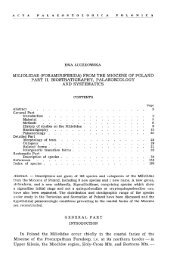The skull of Velociraptor - Acta Palaeontologica Polonica
The skull of Velociraptor - Acta Palaeontologica Polonica
The skull of Velociraptor - Acta Palaeontologica Polonica
You also want an ePaper? Increase the reach of your titles
YUMPU automatically turns print PDFs into web optimized ePapers that Google loves.
ACTA PALAEONTOLOGICA POLONICA (44) (2) 213<br />
In the Djadokhta Fm sediments at Bayn Dzak (= Shabarakh Usu), the type locality <strong>of</strong> V<br />
mongoliensis, numerous shed dromaeosaurid teeth were found that most probably are teeth <strong>of</strong> this<br />
species. All are between 9 and 14 mm (usually 10 mm) long and 3-5 mm (usually 5 rnm) wide across<br />
the base <strong>of</strong> the crown. Some <strong>of</strong> them (Fig. 2C) have preserved serrations on the mesial carina, but<br />
these are most easily visible along the distal portion <strong>of</strong> the crown; close to the tip, the serrations are<br />
worn <strong>of</strong>f. In these teeth, the average number <strong>of</strong> denticles on the mesial carinae is 7 per 1 mm. <strong>The</strong> dis-<br />
tal carina is thin and serrated, the number <strong>of</strong> denticles being, on the average, 5 per 1 mm. Denticles are<br />
somewhat more crowded close to the base <strong>of</strong> the crown. Some <strong>of</strong> these teeth have a wear facet on one<br />
side, which is located near the tip <strong>of</strong> the crown.<br />
<strong>The</strong> interdental plates are indistinguishable in <strong>Velociraptor</strong>, their presence being probably obscured<br />
by fusion, as in other dromaeosaurids. However, the lingual margin <strong>of</strong> the tooth sockets is as high as the<br />
labial margin, which, as suggested by Currie (1995), may indicate that the plates are present.<br />
In Deinonychus, there are four premaxillary and 15 maxillary teeth, and a maxi-<br />
mum <strong>of</strong> 16 dentary teeth. <strong>The</strong> discrepancy between numbers <strong>of</strong> teeth in the upper and<br />
lower jaws is smaller (or, maybe, none) in <strong>Velociraptor</strong>, 13-15 teeth being present in<br />
the upper jaw and 14-15 teeth in the mandible. Sues (1977a) has counted only three<br />
premaxillary teeth in the holotype <strong>of</strong> V mongoliensis. However, on all other specimens<br />
there are four premaxillary teeth as in other dromaeosaurids and in most other<br />
theropods. According to Sues (1977a) there are nine or ?ten maxillary teeth in the<br />
holotype <strong>of</strong> V mongoliensis. Nine teeth are present in the maxilla <strong>of</strong> Dromaeosaurus.<br />
Discussion<br />
Skulls in Deinonychus antirrhopus and <strong>Velociraptor</strong> mongoliensis, as well as in<br />
Saurornithoides langstoni were considered by Paul (1988) as much more similar to<br />
each other than either is to the <strong>skull</strong> in Dromaeosaurus albertensis, and consequently<br />
he assumed that Deinonychus and Saurornitholestes are junior synonyms <strong>of</strong> Velo-<br />
ciraptor. This opinion has not been supported by Witmer & Maxwell (1996), who have<br />
studied new, more complete material <strong>of</strong> D. antirrhopus, and have drawn attention to<br />
some previously unknown features <strong>of</strong> this species. For example, they stated that the<br />
<strong>skull</strong> was more robust in D. antirrhopus than in V mongoliensis. <strong>The</strong>se new data on D.<br />
antirrhopus, as well as the redescription <strong>of</strong> Dr. albertensis by Currie (1995), have ren-<br />
dered invalid some evidence quoted by Paul in favour <strong>of</strong> his hypothesis, whereas oth-<br />
ers appear to be dromaeosaurid synapomorphies. For example, the nasal is not 'de-<br />
pressed' in Deinonychus (it is unknown in Dromaeosaurus and other dromaeosaurids),<br />
the maxillary alveolar border is also slightly convex in Dromaeosaurus (Currie 1995:<br />
figs 1,2), the cross-section <strong>of</strong> the lacrimal shaft is also U-shaped in Utahraptor (and in<br />
some other theropods; the shaft is not preserved in Dromaeosaurus; the lacrimal is un-<br />
known in Saurornitholestes), the quadratojugal also has the inverted T shape in<br />
Dromaeosaurus, and, as deduced by Currie (1995), the frontal process <strong>of</strong> the post-<br />
orbital was also upturned in Dromaeosaurus.<br />
Our present study has farther increased the number <strong>of</strong> differences between V mon-<br />
goliensis and D. antirrhopus. In the latter species, the maxilla is more robust, the<br />
antorbital fenestra is longer and distinctly triangular, the supratemporal fenestra is nar-<br />
rower but longer, and is bounded laterally by the straight supratemporal arcade. In<br />
V mongoliensis, the supratemporal arcade is laterally bowed and the fenestra is sub-

















